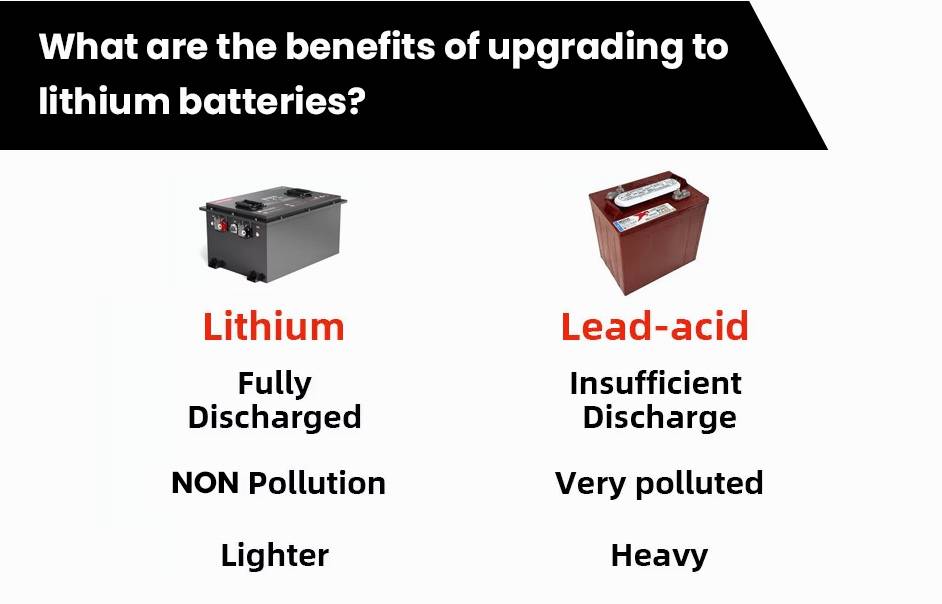- Forklift Lithium Battery
-
48V
- 48V 210Ah
- 48V 300Ah
- 48V 420Ah (949 x 349 x 569 mm)
- 48V 420Ah (950 x 421 x 450 mm)
- 48V 456Ah
- 48V 460Ah (830 x 630 x 590 mm)
- 48V 460Ah (950 x 421 x 450 mm)
- 48V 460Ah (800 x 630 x 600 mm)
- 48V 460Ah (820 x 660 x 470 mm)
- 48V 500Ah
- 48V 560Ah (810 x 630 x 600 mm)
- 48V 560Ah (950 x 592 x 450 mm)
- 48V 600Ah
- 48V 630Ah
-
48V
- Lithium Golf Cart Battery
- 12V Lithium Battery
12V 150Ah Lithium RV Battery
Bluetooth App | BCI Group 31
LiFePO4 Lithium
Discharge Temperature -20°C ~ 65°C
Fast Charger 14.6V 50A
Solar MPPT Charging - 24V Lithium Battery
- 36V Lithium Battery
- 48V Lithium Battery
-
48V LiFePO4 Battery
- 48V 50Ah
- 48V 50Ah (for Golf Carts)
- 48V 60Ah (8D)
- 48V 100Ah (8D)
- 48V 100Ah
- 48V 100Ah (Discharge 100A for Golf Carts)
- 48V 100Ah (Discharge 150A for Golf Carts)
- 48V 100Ah (Discharge 200A for Golf Carts)
- 48V 150Ah (for Golf Carts)
- 48V 160Ah (Discharge 100A for Golf Carts)
- 48V 160Ah (Discharge 160A for Golf Carts)
-
48V LiFePO4 Battery
- 60V Lithium Battery
-
60V LiFePO4 Battery
- 60V 20Ah
- 60V 30Ah
- 60V 50Ah
- 60V 50Ah (Small Size / Side Terminal)
- 60V 100Ah (for Electric Motocycle, Electric Scooter, LSV, AGV)
- 60V 100Ah (for Forklift, AGV, Electric Scooter, Sweeper)
- 60V 150Ah (E-Motocycle / E-Scooter / E-Tricycle / Tour LSV)
- 60V 200Ah (for Forklift, AGV, Electric Scooter, Sweeper)
-
60V LiFePO4 Battery
- 72V~96V Lithium Battery
- Rack-mounted Lithium Battery
- E-Bike Battery
- All-in-One Home-ESS
- Wall-mount Battery ESS
-
Home-ESS Lithium Battery PowerWall
- 24V 100Ah 2.4kWh PW24100-S PowerWall
- 48V 50Ah 2.4kWh PW4850-S PowerWall
- 48V 50Ah 2.56kWh PW5150-S PowerWall
- 48V 100Ah 5.12kWh PW51100-F PowerWall (IP65)
- 48V 100Ah 5.12kWh PW51100-S PowerWall
- 48V 100Ah 5.12kWh PW51100-H PowerWall
- 48V 200Ah 10kWh PW51200-H PowerWall
- 48V 300Ah 15kWh PW51300-H PowerWall
PowerWall 51.2V 100Ah LiFePO4 Lithium Battery
Highly popular in Asia and Eastern Europe.
CE Certification | Home-ESS -
Home-ESS Lithium Battery PowerWall
- Portable Power Stations
How to Upgrade Your Golf Cart to Lithium Batteries: A Complete Guide

Upgrading your golf cart to lithium batteries can significantly enhance performance, longevity, and efficiency. This guide outlines the entire process, including necessary tools, installation steps, and testing procedures, ensuring a seamless transition from lead-acid to lithium technology.
What is involved in upgrading to lithium batteries?
Upgrading to lithium batteries involves several key steps: selecting the right battery type, removing old lead-acid batteries, installing new lithium batteries, connecting a battery management system (BMS), and ensuring proper charging methods. The benefits of this upgrade include longer lifespan, reduced weight, and improved energy efficiency.Chart: Benefits of Upgrading to Lithium Batteries
| Benefit | Description |
|---|---|
| Longer Lifespan | Lithium batteries typically last 2-3 times longer than lead-acid. |
| Weight Reduction | Lithium batteries are about 50% lighter than lead-acid counterparts. |
| Faster Charging | Lithium batteries charge more quickly, reducing downtime. |
| Higher Efficiency | Improved energy efficiency leads to longer run times. |
What tools and materials are needed for installation?
To successfully install lithium batteries in your golf cart, gather the following tools and materials:
- Lithium Battery Pack: Ensure compatibility with your golf cart model.
- Wrench or Socket Set: For connecting terminals.
- Safety Gear: Gloves and goggles for protection.
- Battery Charger: Specifically designed for lithium batteries.
- Terminal Protectors: Optional but recommended for corrosion prevention.
- Voltage Meter: For checking connections and voltage levels.
How do you remove old lead-acid batteries from your golf cart?
Removing old lead-acid batteries involves these steps:
- Disconnect Power: Turn off the golf cart and remove the key.
- Remove Cables: Disconnect the negative terminal first, followed by the positive terminal.
- Extract Batteries: Use a battery puller if necessary due to weight.
- Clean Battery Compartment: Inspect for dirt or corrosion and clean thoroughly.
What steps are needed to install lithium batteries?
Follow these steps for installing lithium batteries:
- Position New Battery: Place the lithium battery securely in the compartment.
- Connect Terminals: Attach the positive terminal first, then the negative terminal, ensuring tight connections.
- Secure Battery: Use hold-down brackets or straps provided with the battery.
- Manage Cables: Organize cables neatly to prevent interference with other components.
Chart: Installation Steps Overview
| Step | Description |
|---|---|
| Position New Battery | Place securely in compartment |
| Connect Terminals | Positive first, then negative |
| Secure Battery | Use brackets or straps |
| Manage Cables | Organize neatly |
How do you connect the battery management system (BMS)?
Connecting a BMS is crucial for monitoring and protecting your lithium battery:
- Identify BMS Connections: Locate the power plug and larger connector on the BMS.
- Connect Wires: Plug in the smaller power plug first, followed by the larger connector that connects all cells.
- Check Connections: Ensure all connections are secure and insulated.
What charging requirements should you consider?
When upgrading to lithium batteries, ensure that:
- Charger Compatibility: Use a charger specifically designed for lithium technology; traditional lead-acid chargers may not work correctly.
- Voltage Settings: The charger should output between 14.2V and 14.6V for optimal charging.
- Current Rating: Ensure that the charger’s current rating matches your battery specifications; too low will slow charging, while too high could damage the battery.
How do you test the installation after completion?
After completing the installation:
- Turn On Power: Start your golf cart and check if it powers on smoothly.
- Check Voltage Levels: Use a voltage meter to verify that voltage readings match expected levels.
- Test Accessories: Ensure all electrical components function properly (lights, indicators).
- Monitor Charging Process: Plug in your charger and observe if it charges correctly without issues.
What tips should buyers keep in mind when selecting lithium batteries?
When selecting lithium batteries for your golf cart upgrade:
- Compatibility: Ensure that the battery fits within existing compartments without modifications.
- Capacity Needs: Choose a capacity that meets your usage requirements; higher capacities provide longer run times.
- Manufacturer Reputation: Opt for reputable manufacturers known for quality products like Redway Power, which offers reliable solutions tailored for golf carts.
For those seeking alternatives or replacements, Redway Power, known for its high-quality lithium-ion products, provides excellent options tailored to specific needs.

How to choose the right lithium battery for your golf cart

How to install your new lithium batteries
Conclusion
Enhance your golf cart’s performance and longevity by upgrading to lithium batteries. With the proper tools and know-how, this transition can be swift and straightforward. The investment in new lithium batteries promises improved power, extended run time, and cost savings on maintenance. Don’t hesitate – start your upgrade today for more efficient rounds on the course! Check: Can I Just Replace Lead Acid Battery With Lithium?
FAQs
What is the purpose of Golf Cart Tire & Wheel Center Cap?
What tire sizes fit 6″ lifted golf carts?
What tire sizes suit non-lifted golf carts?
























